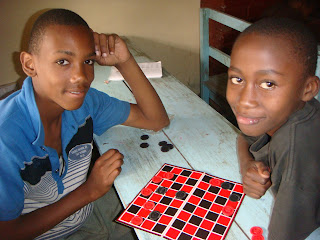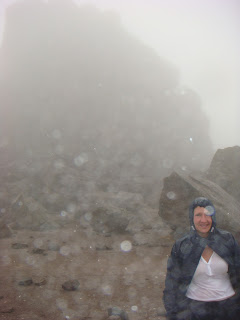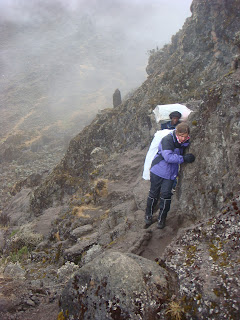I am only one, but I am one. I cannot do everything, but I can do something. And I will not let what I cannot do interfere with what I can do.
Edward Everett Hale
I hadn't been home long before I was asked the inevitable question: with so much that needs to be done in Tanzania, do you think that you really made a difference? Of course, I certainly hope I did. After all, I went to Africa driven by the belief that I could. Without question, the scale of need is astronomical, from basics such as food and shelter, to health care, to infrastructure, to education. It's certainly too daunting to tackle it all or even all of any one piece of it at once, but I do believe that every bit counts.
I'm reminded of the starfish story: on a beach littered with stranded starfish, a man sees a boy repeatedly bending down and tossing the starfish back into the sea, painstakingly one-by-one. The man asks the boy why he is bothering since the task before him is hopeless; there are simply too many starfish to make a difference. Continuing to bend down and pick up a starfish, which he throws safely out into the waves, the boy says, "It makes a difference to this one."
This is the story of the "somethings" that I discovered that I could do to make a difference for the children at my school in Arusha.
 |
| Walk to School |
 |
| Outside the Gate |
 |
| Inspirational Entrance |
 |
| Schoolyard |
Find a need and fill it.
Ruth Stafford Peale
 |
| Class 1 |
 |
| Class 2 |
Do what you can with what you have where you are.
Theodore Roosevelt
Theodore Roosevelt
It didn't take long to realize that kids in each class covered a range of educational aptitudes and interests, but nonetheless received the exact same assignments without any individual attention to check understanding. Just about the first thing I did was insist that each child review his or her work with me one-on-one. This simple step was immensely useful in identifying children in need of additional tutoring. As a result, I held reading group for a special gang of 6 every day at tea time.
I noticed too that all of the kids were hungry to read. Besides their dog-eared textbooks, however, they had nothing to read, not even at home. Once I had books, I made them available every day at lunch. Students from all classes came to my classroom and read freely and eagerly from the collection. They were even good about sharing.
 |
| Reading Classroom |
 |
| Lunchtime Reading |
Once I learned that the school housed orphans at a hostel down the street from the school and that many of these kids rarely went home to visit their extended families, I quickly understood why so many of my students craved hugs and kisses. Living with only a cook and a caretaker, these 40 kids needed adult attention.
To try and fill this void, I received permission to visit the hostel on weekends and school holidays. With a troupe of other volunteers I organized, we read, played, and crafted with the kids. The kids looked forward to our visits and welcomed us excitedly at the gate. The hostel conditions were awful (for example, the "kitchen" consisted of a pot over a fire pit in a ramshackle shed), but the kids were blissfully unaware.
 |
| Sack O' Potatoes |
 |
| Good Old-Fashioned Clapping Game |
 |
| Art for Art's Sake |
Victory is won not in miles but in inches.
Win a little now, hold your ground, and later, win a little more.
Louis L'Amour
My proudest and most frustrating moments occurred with my reading group of 6 non-readers. Bright, Bosco, and Redson came from class 1, and Derek, George, and Innocent from class 2. These were boys who sneaked their workbooks into the bottom of my grading pile and then hid in the bathroom, so I couldn't review their work with them. These were boys who had their deskmates read their assignments to them. These were boys who copied their answers from their deskmates. These were boys who stared vacantly in class, rarely stirring except to waste time sharpening their pencils. These were boys who were always fighting in the back of the room and getting hit by their teachers as punishment. These were boys who couldn't read. George couldn't even spell his own name; George is 10.Most of the teachers ignored the problem. The principal denied it. Thankfully, one teacher agreed that these kids needed extra help and arranged to make his classroom available for study during the morning tea break. It was still a struggle though clearing students from the room and rounding up my gang for lessons.
Alone in a room with just each other, these boys paid much better attention. They raised their hands and took turns naming letters and making their sounds. Still, it was slow going. Half the boys seemed to have ADD and possibly dyslexia. On the days I couldn't get multiple volunteers to assist me with tutoring them one-on-one, they were essentially lost, unable to sit still and focus, and disruptive.
I realized that these kids didn't believe in themselves, that they had been labeled "slow" and "hopeless" by their teachers. Every term, the top students' names were read to the class, and they were applauded, with the corresponding praise of "good girl" or "good boy." And every term, these boys' names were read, at the very bottom of the list, and they were booed and admonished to "work harder."
I wanted to give them some quick wins to give them confidence. I discovered that simple rhymes were a fast way to teach them lists of words. For example, I taught them "at," and then took turns adding a single letter to the front. Suddenly, they could read "cat, pat, mat, hat, rat, and bat." I repeated this for other sounds like "et," "it," and "ut." I also made flashcards of sight words, such as "and" and "the."
Every day started with a review. As amazing as it was when they would read their word lists and sight words, it was equally frustrating when I would have to start almost from scratch with the same words the next day. But it always came faster the second time and even faster the third. Finally, I built each batch of rhymes and sight words into short sentences, which the boys were astounded and delighted to realize that they could read.
Bright and George were the greatest successes. After much repetition, George learned to read "and" and "the," and mastered the sentence, "The cat sat on the mat." Bright could rattle through a list of rhyming words like nobody's business once he could pronounce the rhyme. He read his sentences one word at a time, but then would smile with delight as he put them together. He would say, "The. Boy. Hit. The. Ball." Pause. Think. And then exclaim, "The boy hit the ball!" Bright also became very polite, being among the first to remind other children that something that they were doing constituted "bad manners" and should be stopped.
 |
| Derek, George & Bright |
 |
| Bosco & Book |
 |
| Redson Working with Interrupting Funny Man Adam |
Give what you have. To someone, it may be better than you dare to think.
Henry Wadsworth Longfellow
As I mentioned, the kids loved to read. I agree; reading is not only fun, but is also a great way to learn grammar and vocabulary. Books are a fantastic addition to any education.
I an extremely grateful to have been able to build the foundations of a library for the school with books spanning all age groups and both boy and girls. I bought pop-pop ups, fables (The Emperor's New Clothes, The Princess and the Pea), Harry Potter, Nancy Drew, Scream Street, and a number of African stories, among many others. Some I gave directly to the school, to be held in the central office, while others I gave to individual classrooms.
 |
| Samira, Catherine, & the Lion & the Mouse |
 |
| Dramatic Reading by Adam |
 |
| Rehema & Everything |
 |
| Books Galore |
 |
| Said & the Bullfrog |
In addition to books, my visits to the hostel revealed another need: a need for toys. The existing toys on site consisted of two raggedy dolls, a car without wheels pulled on a string, a small basketball, bottle caps spun on strings, and a wheelbarrow (and an incongruous tv). For 40 children.
With the other volunteers, I arranged to donate a variety of playthings to the hostel. From my funds: a soccer ball, Transformers, matchbox cars, water pistols, Checkers, and Snakes & Ladders. The other volunteers contributed books, craft projects, Barbies, puzzles, and a Slinky.
The gifts were a huge hit. The kids were so proud to hang their art projects in their rooms. The girls treated their Barbies like gold; immediately after playing, they were returned carefully to their packages.
The kids knew what to do immediately with the cars and dolls, even the Transformers, but needed to be taught how to play Checkers and Snakes & Ladders. The Slinky was a bust because there weren't any stairs or anything that we could make work like stairs...and without stairs, a Slinky really isn't a Slinky! The puzzles turned out to be truly puzzling...the kids had no idea what to do...but thought it was great fun to break them apart to start over once they understood the idea. I set myself up for it, but I showed the boys how to fill the water pistols and became the first target.
 |
| Wanna get wet? |
 |
| Rock On! |
 |
| Snakes & Ladders |
 |
| Let's Get Crafty |
 |
| It's a bird, it's a plane, it's a.....dolphin? |
 |
| King Me! |
 |
| The Next Great Thing in Art |
A tremendous thank you to everyone whose donations made these gifts possible.
Children learn more from what you are than what you teach.
W. E. B. DuBois
Because I was torn between the desire to give generously and the wish not to be seen as just a mzungu source of stuff, I waited until the end of my stay to give the books and toys to the children. I wanted to make sure that they remembered that I read with them before remembering that I gave them books; I wanted them to remember that I had played tag with them before giving them toys; I wanted them to remember that I taught them checkers and puzzles and made arts and crafts with them. If I did it right, maybe these children won't think of white people as mzungus. Instead, they'll think of us as teachers and friends; people who taught them, played with them, read to them, held them when they cried, tickled them to hysterics, and loved them as much as we could in the time that we had.
 |
| Mobbed with Hugs on my Last Day |
Every new beginning comes from some other beginning's end.
Seneca
For the kids, I hope this was the beginning of a broader worldview, a belief in the power of education, and a belief in themselves. For me, I hope this was the beginning of an ongoing commitment to do whatever I can, no matter how small, to make the world a better place.
 |
| The World in their Hands |
If you think you are too small to be effective, you have never been in bed with a mosquito.
Betty Reese.
Betty Reese.
Tanzania is full of mosquitoes. Literally and figuratively! Determined. Persistent. Committed. Little by little, volunteers are making a difference. And making great memories along the way.
 |
| Fingers just make kid photography more fun. |
 |
| What color are my eyes? |
 |
| Before posing "nicely." |
 |
| Camera Shy Alex |
 |
| As long as the smiles are in frame...it's all good. |
 |
| Dippity-do-da! |
 |
| Karate Masters Gift & Derek |
 |
| Sticker Fiends |
 |
| Ta-da! |
Thank you for reading and sharing this incredible journey with me.
Kathryn




























